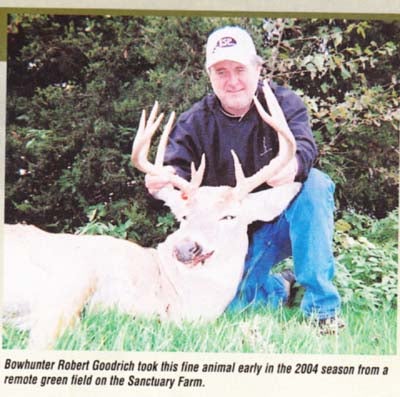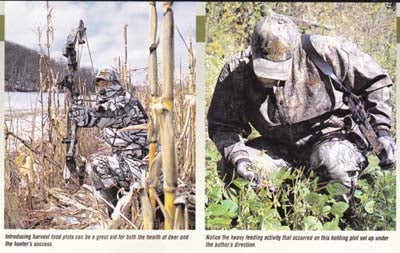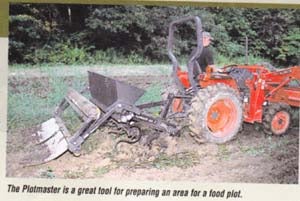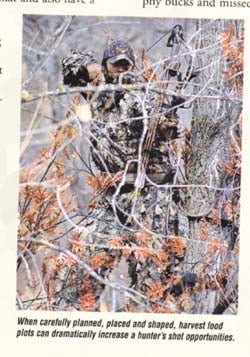Nutrition food plots for deer
Nutrition in food plots for deer
Bow and arrow magazine May 2005
Steve Bartylla-
In this article, the first of a two part series, I will delve into the advanced food plot strategies I put in place on this specific deer property. In the next issue, we will cover scouting, marking stand locations for each phase of the season and selecting low-impact stand routes. Best of all, this seldom seen inside look at a premier outfitter’s approach can be applied to any whitetail hunting land, allowing you to get the most from your property.
YEAR ROUND NUTRITION in food plots for deer
For a deer property to reach it’s full potential, the deer themselves must have an adequate amount of high-quality, year round nutrition. Having plots that draw and hold deer during the season is also important, but deer simply can’t meet their own generic potential unless adequate nutrition is available 365 days year. If quality food sources are lacking during any one season the resident deer will have poor reproduction rates, body size and antler size, and their overall health will suffer.
Furthermore, drawing and holding deer on wwwPerformanceOutdoors.com;s properties has obvious benefits. The more time deer spend on their properties; the better they can protect the local herd from other hunters and poachers. This allows young bucks to grow old, which will increase their hunter’s odds of harvesting what they helped to produce.
However, before any of this was possible, we first needed to. identify what nutrition the deer required. Much like people, deer need to consume a balance of fats, carbohydrates and protein.
Food high in fats and carbohydrates is great for building fat reserves and supplying energy. When deer are preparing for enduring winter, this can be critical, particularly in the Upper Midwest and areas further north. it’s also equally important for southern deer that must endure drought induced food shortages.
Though seldom mentioned, fats and carbohydrates also indirectly play a significant role in antler development. During the spring, the first thing bucks address ls building their bodies back up from the toll that both the rut and winter took on them. With a worn-down body, they’ll have little energy-energy that can go into growing healthy, large antlers. Since diets high in fat and carbs help to build
and maintain fat, they create potential energy reserves for deer that must endure the negative energy balance. This is why it’s important during the late fall and winter for deer to get the energy they require for healthy antler growth.
On the flip side, the important role that protein plays in antler development is well documented. A buck requires diets consisting of 20 percent or more protein to produce quality antlers. Recent studies have shown that this level is needed even before velvet antlers begin to form. To get maximum antler production, these levels should be provided from mid-winter on through the shedding of velvet.
Furthermore, protein levels are also important for fetus development, milk production, muscle development and overall health. Though certain vitamins and minerals are also important, satisfying a whitetail deers needs for fats, carbohydrates and proteins is a great place to begin.
HOLDING PLOTS nutrition in food plots for deer
My first task is always to ensure that the property has enough nutrition to draw and hold deer. In doing this, I want many holding plots to be centrally located on the property. First, that positioning makes it much harder for neighboring hunters to take advantage of my efforts. Second, it helps inspire more deer to bed on the managed properly.
Finally, it provides the hunter with much lower impact routes to and from stands. All too often prime food sources either dot or surround the outer edges of hunting properties. When that is the case, the hunter is often forced to kick out deer when crossing the fields. Furthermore, it becomes much
more difficult for the hunter to slip into stands between bedding and feeding for morning hunts. A centrally placed food plot fulfills all concerns a hunter might have.
Size is another concern for holding plots. Since they will be the backbone of our nutrition plan, holding plots must be large enough to produce the volume of forage that resident deer will require. There is no set formula for determining this size requirement. It becomes a balance of other available forages, crop yield and deer density. When other feeding options are limited, our planting yield is low and deer density is high we must have larger holding plots than when the reverse is true. As a general rule of thumb, I never make holding plots of grains less than five acres
and plots of greens less than two acres.
Luckily, The Sanctuary Farm already had hay, soybeans and cornfields centrally located. In this case, it was simply a matter of buying standing corn and beans from the farmer. Doing so ensured that adequate carbohydrates and fats would be available to deer on the
property, and the hayfield would provide the initial supply of protein.
HARVEST PLOTS
With a good start on holding plots, I shifted my attention to creating harvest plots that would
further address the protein deficiency during late winter, spring and summer. Though harvest plots
certainly can help address nutritional needs, they are also geared more toward effectively positioning deer for a shot. To do so most effectively, they must contain the most highly desired food source in the area, and they must provide a feeling of safety, which means they must be ideally located. Since harvest plots are designed for on-site hunting, it stands to reason they require plantings that are most effective at drawing deer. When selecting a crop, I most often
go for greens. It has been my experience that deer will gravitate to certain greens as long as they are in an ideal growth state. The only food source that I have found that can consistently draw deer better are acorns.
Because of this, I commonly plant a harvest plot in half clover or alfalfa and half Antler King’s Fall/Winter/Spring or Buck Forage Oats. Clovers and alfalfas can be counted on for drawing in deer until a heavy frost turns them sour. Once that occurs, few native or planted greens can still be desirable.
However, Antler King’s Buck Forage Oats can survive and thrive in all but deep frosts, as can the
Fall/Winter/Spring mix. Splitting a harvest plot between clover or alfalfa and half Fall/Winter/Spring or Buck Forage. Oats creates a location that will draw deer from the season’s opener on through the closing day.
To provide the feeling of safety the harvest plot should either be tucked in remote corners of open fields or in their own one- or two-acre opening. Surrounding them as much as practical with escape cover encourages daylight feeding.
Achieving ideal location for a food plot requires knowing
the habitat and how deer use it.
To put things in perspective, before I even began planning wwv. PerformanceOutdoors. com’s harvest plot locations I had already spent several days scouting in both the winter and spring. This was important to get an accurate picture of early-and late-season deer-movement patterns.
While scouting, I placed a premium on locating bedding areas and funnels.
These findings led me to select the locations for the harvest food plots. By knowing where the bedding areas and funnels were. I could position the plots
to force deer through funnels while going to and returning from the food sources.
It’s occasionally possible to do that and also have a funnel divide two existing food sources. That’s the position I took to shoot the buck at the beginning of this article by knowing the deer’s patterns before planning plot locations, I was able to encourage them through an already good funnel. Bucks traveling between feeding an bedding, as well as those cruising between food sources to check for does, would likely pass this stand site.
When funnels don’t exist, placing harvest plots between bedding areas and holding plots is a good option. Often, mature bucks aren’t willing to step into the larger holding plots until after dark. However, those same bucks commonly will engage in daylight feeding in the smaller, seemingly safer harvest plots. By positioning it between bedding and the holding plot, many deer that would otherwise go directly to the holding plots will first snack in the harvest plot.
Finally, the shape and size of these harvest plots can be molded to further maximize shot opportunities. Relatively. narrow elbow or horseshoe-shaped plot’s, between one and
two acres in size, provide the ultimate in close encounters. When given the choice, deer prefer to be able to see the entire plot at once. To do this, they must feed at the point in the bend where they can see both ends. At the very least, the majority of bucks will walk through that point to investigate the other side.
In either case, stands positioned at the mid-point of the plot, on both sides of the bend point, will provide shots at any of these animals. As a bonus, this placement also allows one of the two stands to be safely hunted during any wind direction. Something, as seemingly little as the shape of our of harvest plot can dramatically increase the number of deer harvested from these stands.
During the 2004 archery season,
www. PerformanceOutdoors.com’s hunters took four trophy bucks and missed shot opportunities at three others on their 55-acre Sanctuary Farm. Just as important, trophy buck sightings continued throughout the entire season.
As you will see in the next part of this series, many factors played into this success. However, the well-planned food plot strategy played a significant role. -When a property possesses adequate protective cover, a combination of well-planned holding and harvest plots, it will increase the health, quality and number of deer on a property as well as make them easier to harvest. Instead of guessing where the deer will feed most, we can dictate to them where they want to be. That alone provides the hunter with a tremendous advantage. As almost any serious whitetail hunter would
agree, we can use every ethical advantage we can get. <— <<
Archived by





